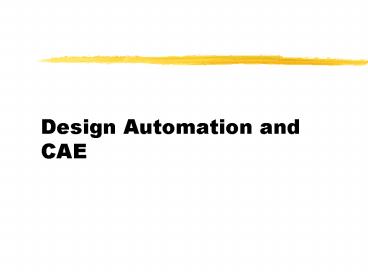Design Automation and CAE - PowerPoint PPT Presentation
1 / 14
Title:
Design Automation and CAE
Description:
Translation software that transfers data from one software to another ... Common applications - statics, transient dynamics, modal, thermal, fluids, ... – PowerPoint PPT presentation
Number of Views:730
Avg rating:3.0/5.0
Title: Design Automation and CAE
1
Design Automation and CAE
2
- CAE - analysis, evaluation of engineering design
data using computer-based techniques to calculate
product OPERATIONAL, FUNCTIONAL, MANUFACTURING
PARAMETERS - design process - CAD, DFMA
- production engineering - GT, CAPP, CAM (NC, CNC)
3
- CAD Data Exchange
- Translation software that transfers data from one
software to another - Translators also transfer data from CAD to CAM
software - DXF Format
- Drawing Exchange File (Drawing transfer file)
- allows CAD data to be written in ASCII file that
contains information about the design. Can be
read by other CAD software or CAM to generate NC
codes
4
- IGES - Initial Graphics Exchange Standard
- Initially developed by NIST and adopted later as
ANSI and ISO standards - IGES contains data on geometric entities and
parameters associated with the entities - PDES - Product Description Exchange Standard
- has been broadened to stand for Product
Description Exchange for STEP - PDES - US effort and STEP - European effort
together now becoming an ISO standard - defines product data from design to production
including Solid modeling (CSG, B-Rep, e.t.c),
process plans, pre-processors for FEA, e.t.c.
5
Design for Manufacturing and Assembly
Design for Manufacturing and Assembly (DFMA) is
any procedure or design process that considers
the production factors from the beginning of the
product design - Design an activity from
conceptualization to evaluation must focus on
generating designs that meet market
specifications and can be manufactured
cost-effectively
6
- DFMA started with two separate thrusts
- producibility engineering - produce simpler parts
that are easily manufactured - design for assembly - reduce number of parts by
eliminating or combining them - DFMA - a holistic approach to design analysis
since both manufacture and assembly are
considered simultaneously. - Result - reduced total product costs (NB - 70 of
product cost are design oriented 80 of quality
problems are because of poor design).
7
- DFMA Process-
- step-by-step procedure to query the designer
about part function, material limitations, part
access during assembly. - Software calculates assembly time, product cost
and benchmark theoretical min. no. of parts. - The manufacturing component of the software will
access various material options (e.g. steel vs
plastic) or manufacturing processes (e.g.
machining vs die-casting) for most cost-effective
production.
8
- DFMA Evaluation
- Apply design guidelines
- Assembly method scoring chart
- Both these are easily built into the software.
- In the DFMA software systems, designer will enter
specifications and the software will provide a
quantitative analysis for the alternative designs - Discuss Ex. 5-1 and 5-2
- Group activity - see handout.
9
Computer-Aided Engineering
- CAE provides a wide variety of software for
engineering analysis of designs - In many modern applications, CAE data is obtained
from CAD drawings - Systems are linked through CAE so that different
applications can share information in the
database e.g. FEA, NC - For design automation, several areas of CAE are
used
10
- Finite Element Analysis
- numerical technique for analyzing and studying
functional performance of a structure or circuit - structure is divided into a number of small
ELEMENTS - analysis of the structure by applying some
numerical techniques - post-processing and interpretation of results
- Common applications - statics, transient
dynamics, modal, thermal, fluids,
electromagnetics, motion
11
- Static analysis - stresses, strains and
deflections under static loads - Transient dynamic analysis - stresses and
deformations, natural frequencies and frequency
response under dynamic loads - Modal Analysis - natural frequencies, mode
shapes for free vibrations - Thermal analysis - temperatures and heat transfer
- Electromagnetic analysis - behavior under
electromagnetic fields - Motion analysis - kinematics (displacement,
velocity and acceleration) - Fluid analysis - flow, diffusion, dispersion, CFD
12
- Mass property analysis
- a CAE function of CAD that returns numerical
values which describe the properties of the
geometry selected. - 2-D areas, centroids
- 3-D volume, mass, surface area, centroids,
moments of inertia - Mass property is usually in-built in the CAD
software - reduces time and effort by designer to
calculate these entities
13
- Interference Checking
- checks 2-D models for interferences between
components e.g. in mechanical assemblies - Tolerance analysis
- checks for tolerances and how they affect
manufacture, assembly and overall dimension - Kinematics and dynamics analysis
- analysis of motions esp. of mechanical linkages
- Discrete Event Simulation
- model complex operations such as those in a
manufacturing cell
14
- Conclusions
- What is the significance of
- DFMA
- FEA
- Mass property analysis
- to Automation Design?
- PP 150 - 154 List CAE software for other
functions - To be covered later RR, GT, CAPP, CAM/NC-CNC,
Communications































